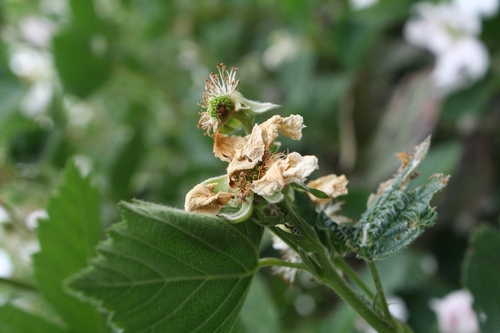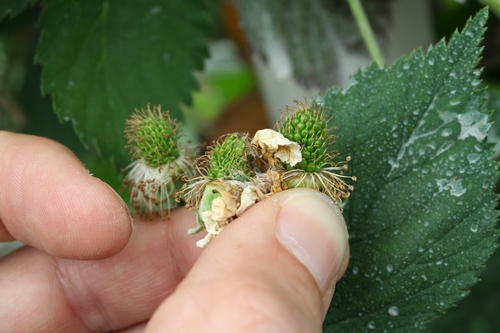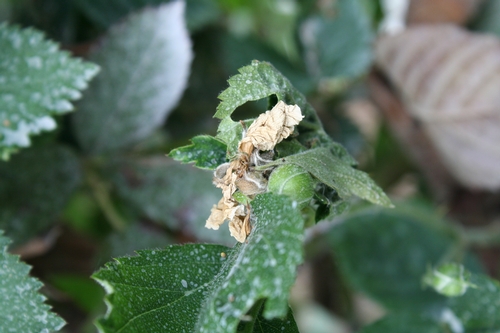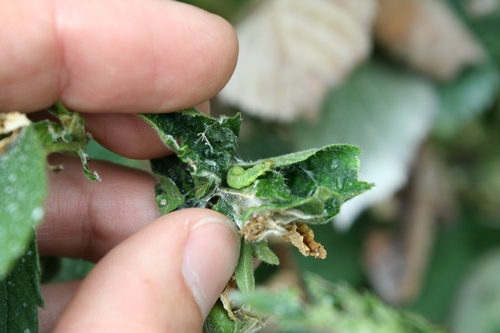
Posts Tagged: pheromone
Targeting the Asian Citrus Psyllid
A major citrus pest may experience a “Bah, Humbug!” kind of year. If all goes as...

The Asian Citrus Psyllid Team: Scientists in the front row (from left) are Tatiana Mulinari, Rodrigo Magnani, Antonio Juliano Ayres, Walter Leal, Marcelo Miranda, Victoria Esperanca, Odimar Zanardi, and Rejane Luvizotto. The three scientists in back are Haroldo X. L. Volpe (white shirt) Renato de Freitas and Rômulo Carvalho.
Spring Treatments for Backyard Fruit Tree Insects: Codling Moth
[From March 2013 issue of the Retail Nursery and Garden Center IPM News.] March is the time to...
A Review on Managing LBAM in Watsonville
Blackberry growers in the Pajaro Valley should be aware that there are substantial numbers of light brown apple moth (LBAM) larvae active in many fields right now. The photos below outline what this pest looks like and what it is doing right now in our blackberry fields.
In the photographed field, there were on the order of 7-9 leafrolls per two feet of hedge in the heaviest infested areas and in excess of 80% of the leafrollers sampled in the photographed field were identified as having a very high likelihood of being LBAM. This is very concerning, since under the current quarantine enforced by the USDA, the presence of any leafroller in a field can be cause for significant delay of harvest much less outright field closure if an LBAM is found.
While clearly not the level of devastating 100% loss of harvest caused by field closure for a positive LBAM find, LBAM itself is also capable of causing some damage. As one can see from the photos below, damage ranges from incidental feeding on flowers resulting in blemished (thus unmarketable) fruit to heavier feeding causing abortion of entire laterals and the subsequent loss of fruiting potential there. In the field photographed below there was damage of some sort to one of every sixteen fruiting laterals.
Anecdotally, it appears that growers who kept up with changing out pheromone based twist ties every four to six months have very low populations of LBAM suspect leafrolls, while those who allowed pheromone coverage to expire before putting up a fresh set are tending to have heavier, in some cases very heavy, larval infestations. If one is not going to be using pheromone based twist ties through the entire year, it is at least a good idea to put out a few pheromone traps to find out when adult males are starting to fly and looking to mate so as to better target use of mating disruption techniques.
As it seems many of the larvae being discovered currently are in the fourth to late instar stage (½ to ¾ inches in length), applications of Bacillus thuriengiensis formulations will not prove to be very effective. Better materials are the spinosyns, one of which (Entrust) is registered for use in organic fields, and bifenthrin (hard on beneficials though). Addition of a good surfactant is always a good idea to break spray water surface tension to facilitate movement of material into even the tightliest wound leafroll.
There are several insecticides mentioned for control of light brown apple moth in this article. Before using any insecticides, check with your local Agricultural Commissioner's Office and consult product labels for current status of product registration, restrictions, and use information.

Flower destroyed by leafroller- note damaged immature fruit at top- once blemished like this it will not make properly

Flower and adjacent fruit destroyed by leafroller

Fruit lateral destroyed by leafroller

Leafroller emerging from destroyed lateral
Insect Art
You'd never know by his stunning art work that Christopher Marley once hated insects. (At right: a...

Christopher Marley
Using Pheromone Based Twist Ties for the Management of Light Brown Apple Moth in Strawberries
Mark Bolda
Hillary Thomas
The use of pheromone based twist ties has found significant success in reducing the incidence of light brown apple moth mating in caneberries grown on the Central Coast of California. With the recent advent of light brown apple moth infestation in area strawberries, especially those in organic production, there has been a groundswell of interest on testing the same technology there.
The following is a brief description of a trial mounted on the part of the authors in testing whether the use of pheromone based twist ties could be useful and successfully applied in strawberries. On June 15, twist ties wound around chopsticks were distributed evenly (every other strawberry row with 16 to 18 feet between each stick) across 8 acres of organic strawberry at the rate of 300 per acre (higher end recommended label rate), with another 8 acres left alone as an untreated check. This was replicated 4 times in various fields around Watsonville.
A matrix of twelve traps using pheromone lures was placed in each 8-acre field to test the ability of the pheromone based twist ties to prevent males from finding females emitting the same pheromone. The idea is that if the males are unable to locate the pheromone lure in the trap, they will not be able to locate females and subsequently not be able to mate, resulting in population reduction.
Traps were checked yesterday, June 29. Out of the 48 total traps placed over the four treated plots, only a single male moth was captured, while the traps in the untreated check contained two moth males on average.
Trap Captures of Light Brown Apple Moth Males, June 29, 2010
Totals are from 12 traps in each plot
with pheromone without pheromone
Field 1 1 23
Field 2 0 27
Field 3 0 23
Field 4 0 42
The results suggest the twist ties may be useful as part of an integrated strategy to reduce light brown apple moth populations in fields, especially for organic growers who have limited available management tools.

Photo Courtesy Hillary Thomas, UC Davis

Photo Courtesy Hillary Thomas, UC Davis
